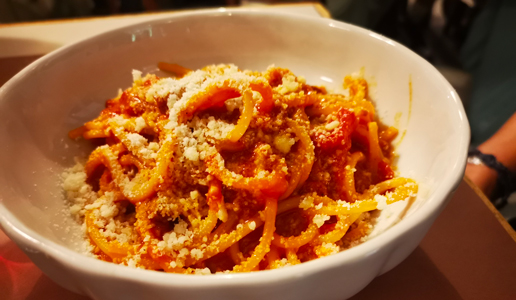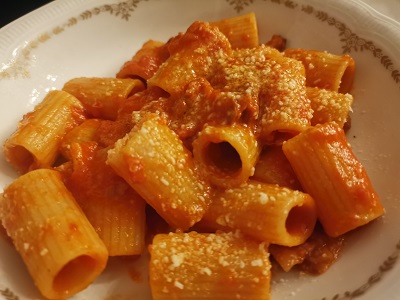The story of the amatriciana

Although considered a typical Roman dish, its origin is in reality from the Abruzzo-Lazio countryside, the town of Amatrice, and it is defined by two fundamental ingredients: guanciale and percorino cheese.
Amatrice is, or perhaps was considering the horrific 2016 earthquake, a medieval town. Up until 1927, when Mussolini decided that Lazio, whose capital is Rome, should be a bigger region, it was part of the Abruzzo region. It is also near the border with the Marche region, which begins just after the towns of Illica and Accumoli, a few kilometers to the east, and not far from what used to be the border separating the provinces of Terni and L’Aquila, in other words the border between the regions of Umbria and Abruzzo.
The area is an authentic Apennine melting pot, one where different traditions intertwine and where Abruzzo and Neapolitan traditions meet, thanks to being where the Kingdom of the Two Sicilies and the Papal States reached. Before then, during the early middle ages, it was ruled by the Church, the ex-Byzantines, the Lombards and the Franks.
The “Matriciani” people are the product of these encounters and some of them emigrated to Rome where they became innkeepers, bringing to the capital their dishes and ingredients, above all guanciale (pork jowl) and percorino (sheep cheese), two gastronomic gems from that area. Then again, pigs and sheep were the two most logical and traditional livestock raised by the people living in the central Italian Apennine Mountains, where there were no plains to raise cattle.
 However, their traditions changed in an urban context. Tomatoes were added to their typical pasta sauce, an ingredient that was not common in the mountain area of Amatrice, and bucatini pasta was also adopted, it being of Sicilian origin probably brought to Rome by some “itinerant” cook. In Amatrice, on the other hand, spaghetti was the type of pasta used, never bucatini, and more than likely the sauce would have no tomato in it.
However, their traditions changed in an urban context. Tomatoes were added to their typical pasta sauce, an ingredient that was not common in the mountain area of Amatrice, and bucatini pasta was also adopted, it being of Sicilian origin probably brought to Rome by some “itinerant” cook. In Amatrice, on the other hand, spaghetti was the type of pasta used, never bucatini, and more than likely the sauce would have no tomato in it.
Oddly enough, the gricia pasta dish, which would be an amatriciana without tomatoes, apparently did not originate in Amatrice. This is because the “grici” in Rome were those who sold encased and cured meats, those who more or less in the 17th century arrived from the Canton of Grigioni (Graubünden), in Valtellina, and hence were nicknamed “grici”. This type of dried meat was particularly loved by the Jews who made bresaola using beef, and not pork.
This was the backdrop for what became the “matriciana” (as the Romans call it), which was undoubtedly inspired by what those from Amatrice made but which underwent different modifications and influences. For sure, compared to the “carbonara”, a more recent and stateless dish with no precise tradition, it is on a totally different level. One can argue which is the best type of pasta to use (not bucatini, please), between spaghetti, thicker spaghettoni, rigatoni or mezzi rigatoni, which nicely absorb the sauce. But there can be no substitute for guanciale, which is obligatory, or pecorino cheese from Amatrice, while the jury is still out on the best tomatoes to use. It is a dish that remains rooted in tradition, one that may be open to interpretation but which maintains some precise benchmarks.
My old friend Pietro Micara, who was from Frascati and who passed away some 20 years ago, taught me an important trick. The guanciale must never all be cooked in the tomato sauce “otherwise you’ll boil it”, he said. This means that some of the guanciale should be cooked in a pan apart using only its own fat, some of which needs to be removed to ensure the guanciale becomes crispy. It is then added to the pasta on the plate to give it a crispy edge. Similar advice was given to me years later by Ferran Adrià for a totally different recipe. Consistency, temperature and balance are part of an evolved way of cooking, the chiaroscuro. The “matriciana” made by Pietro Micara was extraordinary, rich and elegant and it’s the way I still try to make it.
Trivia:
Since March 6, 2020, the amatriciana has officially been recognized as a Traditional Speciality Guaranteed (STG) product by the European Union.
In the STG recipe for the amatriciana, the sauce is composed of Amatrice guanciale De.Co. (traditional local product) that is sautéed and doused with dry white wine, San Marzano tomatoes or, as an alternative, quality peeled tomatoes, Amatrice pecorino cheese De.Co. (from the Monti Sibillini or Monti della Laga), extra-virgin olive oil, fresh or dried chili pepper, salt and pepper. The pasta to use with the STG amatriciana sauce is rigorously only spaghetti.

 Italiano
Italiano






